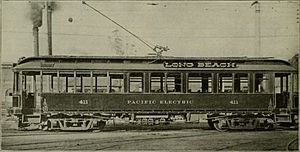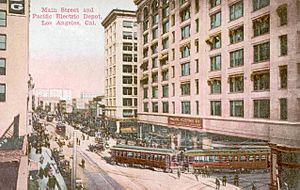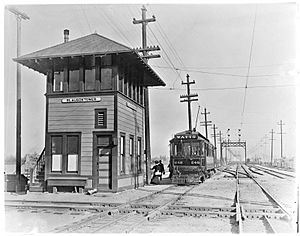Long Beach Line facts for kids
Quick facts for kids Long Beach |
|
|---|---|
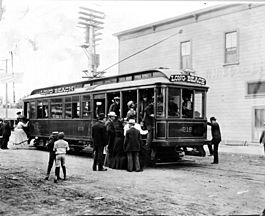
The first day of service in Long Beach, 1902
|
|
| Overview | |
| Locale | Los Angeles, and Long Beach |
| Termini | Downtown Los Angeles Downtown Long Beach, California |
| Stations | 8 |
| Service | |
| Type | Interurban |
| Operator(s) | Pacific Electric (1902–1958) LAMTA (1958–1961) |
| Rolling stock | PE 1200 Class (last used) |
| Ridership | 1,603,476 (1958) |
| History | |
| Opened | July 4, 1902 |
| Closed | April 9, 1961 |
| Technical | |
| Line length | 20.37 mi (32.78 km) |
| Number of tracks | 1–4 |
| Track gauge | 1,435 mm (4 ft 8 1⁄2 in) standard gauge |
| Electrification | 600 V DC Overhead lines |
The Long Beach Line was a very important electric train route. It was run by the Pacific Electric Railway company. This line connected Los Angeles and Long Beach, California. It also passed through towns like Florence, Watts, and Compton.
The train service started in 1902. It ran for many years, finally closing in 1961. It was the last electric train line in the system to be replaced by buses. However, parts of the old tracks are still used today! The Southern Pacific Transportation Company used them for freight (carrying goods). Now, the Union Pacific Railroad still uses some sections for freight. In 1990, a new light rail train, the Blue Line, started running on the same path.
This Long Beach Line was like a main highway for other electric train routes. Many other lines branched off it. These lines went to places like Whittier, Yorba Linda, Fullerton, Santa Ana, Balboa, San Pedro, and Redondo Beach. The northern part of the line had four tracks. Local trains used the outer tracks. Faster, long-distance trains used the inner tracks to pass local stops.
Contents
What Was the Long Beach Line Route?
The Long Beach Line started in Downtown Los Angeles. Its main station was at 6th and Main Street. From there, the tracks went east on an elevated structure. This structure lifted the tracks above the downtown streets. The line then came down to street level at San Pedro Street.
How the Tracks Ran South
The two-track line then headed south. It ran in the middle of the streets. It turned east onto Olympic Boulevard. This part of the line ran right on the street. At Hooper Street, it turned south again. Then, it entered a private area next to Long Beach Avenue. Two more tracks joined here from Pacific Electric's 8th Street Yard. This was the beginning of the four-track system that went all the way to Watts.
The line stayed on its own private path for most of the way. This private path stretched from Olympic Boulevard to Willow Street in Long Beach. The four-track system ended at Watts Junction. From there, the line continued with two tracks to Ocean Avenue in Long Beach.
Key Junctions and Crossings
As the four-track line went south, it crossed Washington Boulevard. At this point, Long Beach Avenue split into two roads, with the train tracks in the middle.
- Amoco Junction: At 25th Street, the Santa Monica Air Line branched off to the west. Another track connected to the Butte Street Freight Yard.
- Slauson Junction: Further south, the line crossed the Atchison, Topeka and Santa Fe Railway tracks at Slauson Boulevard. The Whittier Line branched off to the east here. A large steel bridge carried the four tracks over Firestone Boulevard.
At Watts Junction (103rd Street), the four-track system ended. Here, several other lines branched off. The Santa Ana Line went east. The Redondo Beach via Gardena Line, Torrance Line, and Hawthorne–El Segundo Line went west.
Journey to Long Beach
From Watts Junction, the Long Beach Line (now with two tracks) turned southeast. It ran towards Compton between the two roads of Willowbrook Avenue. After crossing Rosecrans Boulevard, the line turned south. It crossed over Compton Creek on a two-track steel bridge. The line then headed southeast towards Signal Hill.
At Dominguez Junction, the San Pedro via Dominguez Line branched off to the south. The Long Beach Line crossed Alameda Street and the Southern Pacific San Pedro Branch tracks. It then followed the west bank of Compton Creek towards the Los Angeles River.
After the Long Beach Freeway was built, the line crossed over the freeway on a bridge. It then crossed the Union Pacific Railroad San Pedro Branch tracks. A long, single-track bridge carried the line over the Los Angeles River. This was the only single-track part of the entire line.
Arrival in Long Beach
At Willow Street (North Long Beach), the Balboa Line branched off. The Long Beach Line then ran south in the center of American Avenue. This street is now known as Long Beach Boulevard. The line continued to Ocean Avenue in Long Beach. It then turned west onto Ocean Avenue. It followed the same path as the American Avenue–North Long Beach Line. The journey ended at the Pacific Electric station at the foot of Pacific Avenue.
How the Long Beach Line Operated
For many years, Pacific Electric ran special "flyer" trains on the Long Beach route. These flyer trains made only a few stops between Downtown Los Angeles and Long Beach. This was different from the regular service, which stopped at almost every station. The tracks were also used by two local lines: the Watts Line (between Downtown Los Angeles and Watts) and the American Avenue–North Long Beach Line (between Willowville and Long Beach).
Connecting to Other Trains
Pacific Electric also offered a service to connect passengers to long-distance trains. These trains were at the Southern Pacific's Central Station. Electric cars ran from the downtown station to Long Beach and then continued to San Pedro. This service ran from 1924 to 1939. It stopped when Union Station opened. Union Station brought all the long-distance trains to one new location.
History of the Long Beach Line
The idea for the Long Beach Line came from Henry E. Huntington. He started the Pacific Electric Railway in November 1901. Work on the Long Beach Line began right away. The first train service started on July 4, 1902. A test run happened the day before. The line first started at 9th and Main Streets in downtown Los Angeles. In 1905, the main station moved to the Pacific Electric Building. In 1917, trains were rerouted over new elevated tracks west of San Pedro Street. This route was known as line 6.
In 1953, the Long Beach Line was moved to a company called Metropolitan Coach Lines. Then, on March 3, 1958, it was transferred to the Los Angeles Metropolitan Transit Authority. On April 17, its number changed to line 36.
Passenger service on the Long Beach Line ended on April 9, 1961. It was the very last of the old Pacific Electric lines to stop running. Buses replaced the trains. The new bus route was called the 36 "Long Beach Freeway Flyer." It followed the new Long Beach Freeway. Local bus service for the northern part of the line was provided by the 33 "Los Angeles–Compton–Wilmington" bus.
The Southern Pacific Transportation Company continued to use the tracks for freight trains. Their newer company, Union Pacific, still uses parts of the tracks today.
A Southern Pacific train station was built in downtown Long Beach in 1907. It had a special Mission Revival style. It was moved in 1936 and again in 2015. Sadly, it was destroyed by a fire in 2016.
Bringing Rail Service Back
One of the first goals of the Los Angeles County Transportation Commission was to bring back train service on the old Pacific Electric route. They decided to use modern light rail trains. The line was mostly rebuilt for this new service. The Blue Line, which was later renamed the A Line, opened in 1990. It was the first new train line in Los Angeles's modern rail system.
Stations Along the Long Beach Line
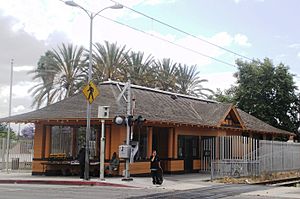
| City | Station | Mile | Service began | Service ended | Major connections |
|---|---|---|---|---|---|
| Los Angeles | Pacific Electric Building | 0 | 1905 | 1961 | Interchange with Alhambra–San Gabriel, Annandale, Balboa, Fullerton, Hawthorne-El Segundo, La Habra–Fullerton–Yorba Linda, Monrovia–Glendora, Mount Lowe, Pasadena Short Line, Pasadena via Oak Knoll, Pomona, Riverside–Rialto, San Pedro via Dominguez, San Pedro via Gardena, Santa Ana, Santa Monica Air Line, Sierra Madre, Soldiers' Home, South Pasadena Local, Whittier |
| Amoco | 1902 | 1961 | Balboa, Fullerton, Hawthorne–El Segundo, La Habra–Yorba Linda, Redondo Beach via Gardena, Santa Monica Air Line, San Pedro via Dominguez, San Pedro via Gardena, Santa Ana, Whittier | ||
| Vernon Avenue | 3.26 | Balboa, Fullerton, Hawthorne–El Segundo, La Habra–Yorba Linda, Redondo Beach via Gardena, San Pedro via Dominguez, San Pedro via Gardena, Santa Ana, Whittier Los Angeles Railway V |
|||
| Slauson Junction | 4.27 | 1902 | 1961 | Balboa, Fullerton, Hawthorne–El Segundo, La Habra–Yorba Linda, Redondo Beach via Gardena, San Pedro via Dominguez, San Pedro via Gardena, Santa Ana, Whittier | |
| Fleming | |||||
| Florencito Park | |||||
| Florence Avenue | |||||
| Nadeau | |||||
| Graham | |||||
| Los Angeles | Latin | ||||
| Watts | 7.45 | 1902 | 1961 | Balboa, Hawthorne–El Segundo, Redondo Beach via Gardena, San Pedro via Dominguez, San Pedro via Gardena, Santa Ana, Watts Line | |
| Abila | |||||
| Springdale | |||||
| Willowbrook | 9.39 | ||||
| Sativa | |||||
| Compton | Winona | ||||
| Compton | 10.92 | 1902 | 1961 | Balboa, San Pedro via Dominguez | |
| Dominguez | |||||
| Dominguez Junction | 13.31 | 1961 | Balboa, San Pedro via Dominguez | ||
| Carson | Del Amo | ||||
| Long Beach | Cota | 16.04 | |||
| Los Cerritos | |||||
| Vista del Mar | |||||
| Willowville | 17.52 | 1902 | 1961 | Balboa | |
| Long Beach | 20.37 | 1902 | 1961 | Long Beach–San Pedro | |
Rolling Stock
By 1924, the Long Beach Line was using special train cars called 1200 class rolling stock. These were the trains that carried passengers along the route.


